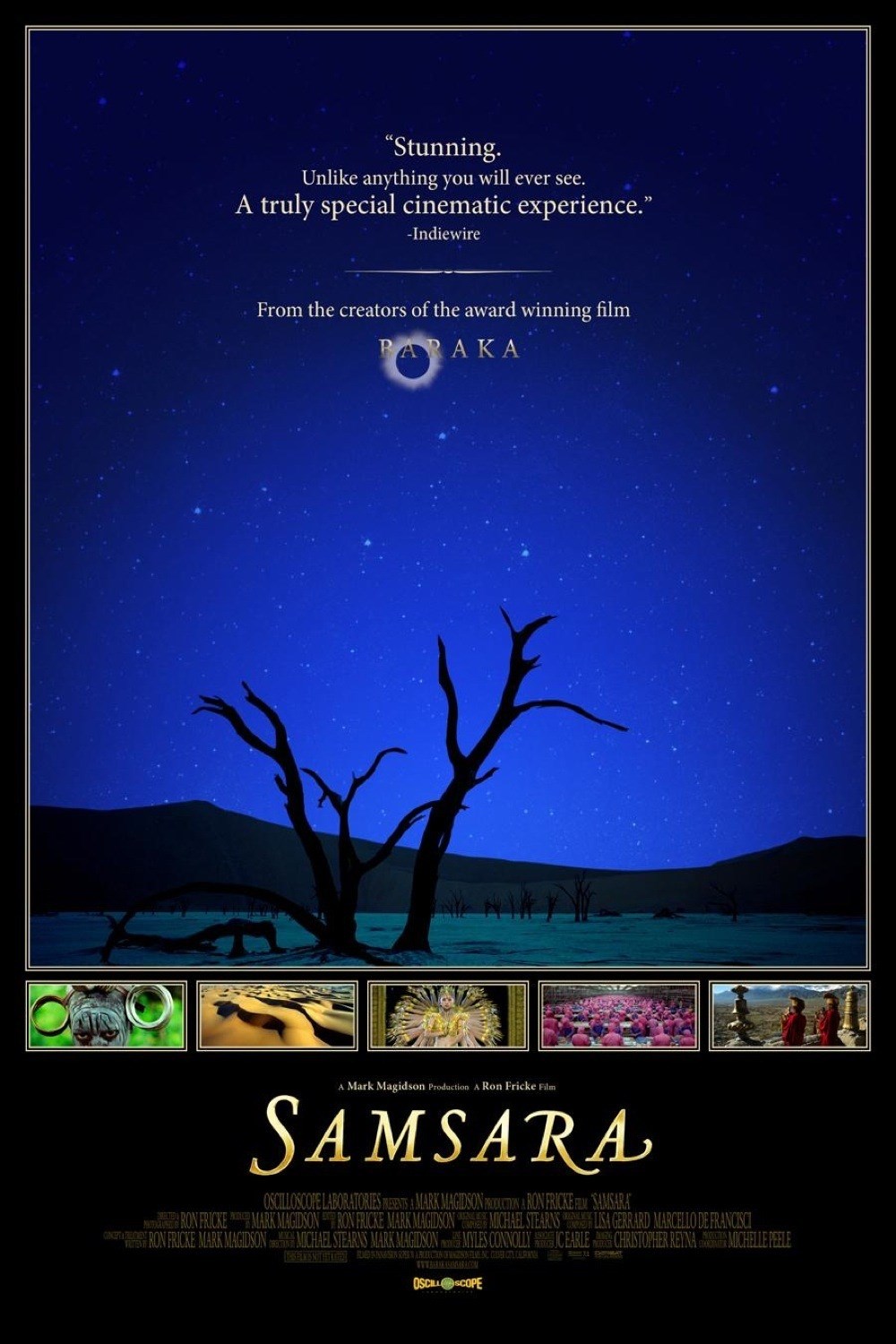Document
Samsara (2011) 4K quality
Samsara is a 2011 American non-narrative documentary film of international imagery directed by Ron Fricke and produced by Mark Magidson, who also collaborated on Baraka (1992), a film of a similar vein, and Chronos (1985).

Title and Year of Release
“Samsara,” released in 2011, is not just a film but a visual meditation on the cyclical nature of life, as its title suggests. “Samsara,” in Sanskrit, means “the ever-turning wheel of life,” a concept central to certain Eastern religions, including Buddhism and Hinduism.
The film’s release at the start of a new decade was timely, offering viewers a moment of reflection and contemplation in a rapidly changing world.
Directed by Ron Fricke and produced by Mark Magidson, the creators of the critically acclaimed “Baraka,” “Samsara” revisits and expands upon the themes and stylistic approach of its predecessor.
It was shot over five years in twenty-five countries, and the film’s 2011 release introduced audiences to a form of visual storytelling that transcends traditional narrative cinema.

“Samsara” serves as a mirror through which viewers are invited to examine the interconnectedness of the human experience, the transient nature of life, and the shared destinies that bind us to the natural world and to each other.
Its release period coincides with a growing global consciousness about issues like environmentalism, spirituality, and cultural diversity, making the film not only a stunning visual journey but also a relevant commentary on the state of the world.
Director
Ron Fricke, the director of “Samsara,” is renowned for his expertise in non-verbal documentary filmmaking and his ability to convey profound messages through powerful imagery.
His directorial approach in “Samsara” is marked by a distinctive use of time-lapse photography, slow-motion, and an astute eye for captivating visuals that explore the beauty and destruction inherent in our world.

Fricke’s direction in “Samsara” reflects his deep interest in themes of spirituality, environmentalism, and the human condition. His work is characterized by a meditative quality that encourages viewers to engage with the film on a personal, introspective level.
By presenting a series of compelling images without a conventional narrative or dialogue, Fricke challenges the audience to draw their own interpretations and to find their own meaning within the film’s visual tapestry.
Under Fricke’s direction, “Samsara” becomes a contemplative journey that transcends cultural and linguistic boundaries, offering a universal message about life, death, and rebirth. His skillful blend of stunning visuals and thematic depth makes “Samsara” a unique and memorable cinematic experience.
Genre of the Film
“Samsara” can be best described as a non-verbal, documentary-style film that defies traditional genre categorizations. It is a visual and musical journey that explores the wonders and horrors of the modern world. The film is often classified as a documentary due to its depiction of real-world scenes and settings, but it differs from conventional documentaries in that it lacks narration, interviews, or a linear narrative.

The genre of “Samsara” is unique in its focus on creating an experience that is both visually arresting and emotionally resonant. It can be seen as an art film due to its emphasis on visual composition, rhythm, and thematic exploration.
The film’s genre blends elements of spirituality, environmentalism, and anthropology, offering a panoramic view of the human experience across different cultures and landscapes.
“Samsara’s” genre is part of a rare breed of cinema that uses the power of images and music to communicate, rather than relying on words or traditional storytelling structures.
This approach allows for a more universal, primal form of engagement with the audience, transcending cultural and linguistic barriers.
Plot and Themes
“Samsara” does not have a conventional plot but is structured as a series of thematic sequences that explore the natural world, human culture, and the intersection between the two. The film traverses multiple countries and cultures, presenting a kaleidoscope of experiences and images that range from the mundane to the sublime.
The themes of “Samsara” are as diverse as its visuals. One central theme is the concept of samsara itself – the cycle of birth, life, death, and rebirth. The film visually contemplates the rhythms and patterns of nature and human life, drawing parallels between the two.
It explores the beauty of the natural world and the complexity of human culture, while also delving into the impact of humanity on the environment.

Another key theme in “Samsara” is the contrast between spirituality and materialism. The film juxtaposes scenes of religious rituals and serene landscapes with those of industrialization and urbanization, prompting reflections on the relationship between human progress and spiritual fulfillment.
“Samsara” also touches on themes of interconnectedness and the shared human experience, transcending geographic and cultural boundaries to highlight the commonalities in human existence.
Cinematography and Visual Effects
The cinematography in “Samsara” is a critical component of its storytelling. Fricke, who also served as the cinematographer, uses a 70mm camera to capture stunningly detailed and vivid images.
The film’s visual approach is characterized by its use of panoramic shots, time-lapse photography, and meticulous framing, which together create a visually mesmerizing experience.
The cinematography is not just about capturing beautiful images; it is also about conveying a message and evoking emotion.
Each shot is carefully composed to reflect the film’s themes, whether it’s the serenity of a sacred site, the frenetic pace of a modern city, or the devastation of an environmental catastrophe.

“Samsara” makes minimal use of visual effects, relying instead on the natural beauty and complexity of its real-world locations.
The visual effects that are used are primarily in the service of the film’s time-lapse sequences, which are masterfully executed to show the passage of time and the movement of life in a way that is both beautiful and haunting.
Character Development
As a non-verbal, documentary-style film, “Samsara” does not have characters in the traditional sense. Instead, it features real people from various cultures and walks of life, each contributing to the film’s tapestry of human experience.
While there is no character development in the conventional narrative sense, “Samsara” offers deep insights into humanity as a whole.
The ‘characters’ in “Samsara” are diverse, ranging from monks creating sand mandalas to factory workers, from tribespeople to city dwellers.
Each individual or group of individuals represents a facet of the human experience, contributing to the film’s exploration of themes like spirituality, consumerism, and the cycle of life.

In “Samsara,” the audience is invited to observe and reflect on these individuals, drawing their own conclusions and emotional responses. The lack of dialogue or narrative exposition allows for a more direct, unmediated connection between the viewer and the subjects on screen.
Conclusion
“Samsara” is an extraordinary cinematic creation that transcends conventional filmmaking boundaries. Its non-verbal, visually-driven approach offers a unique and contemplative experience that delves into profound themes about life, nature, and humanity.
Director Ron Fricke’s masterful use of imagery and composition, combined with the film’s expansive scope, makes “Samsara” a mesmerizing and thought-provoking journey.
The film’s lack of a traditional narrative or characters does not diminish its impact; rather, it elevates “Samsara” to a universal level, allowing viewers from different cultures and backgrounds to engage with and reflect on its themes.
The film’s exploration of the cyclical nature of existence and the interconnectedness of life is both a visual marvel and a profound philosophical inquiry.

In conclusion, “Samsara” is a significant work of art that challenges and expands the boundaries of traditional documentary filmmaking. It stands as a powerful testament to the beauty and complexity of the world we inhabit and the shared human experience that binds us all.
“Samsara” is not just a film to be watched; it is an experience to be absorbed and contemplated, offering insights and reflections that resonate long after the final scene fades.


 Telegram
Telegram
 Facebook
Facebook